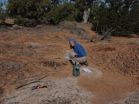Young gamers offer insight to teaching new physicians robotic surgery
Using skills gleaned from video games, high school and college students outmatch medical residents in surgical simulations a new UTMB study finds
2012-11-16
(Press-News.org) What can high school and college-age video game enthusiasts teach young surgeons-in-training?
According to a new study from researchers at the University of Texas Medical Branch at Galveston (UTMB) – a world leader in minimally invasive and robotic surgery – the superior hand-eye coordination and hand skills gained from hours of repetitive joystick maneuvers mimic the abilities needed to perform today's most technologically-advanced robotic surgeries.
To offer insight on how best to train future surgeons, the study placed high school and college students head to head with resident physicians in robotic surgery simulations. The results, presented at the American Gynecologic Laparoscopists' 41st Annual Global Congress on Minimally Invasive Gynecology in Las Vegas, were surprising.
Both high school sophomores who played video games on average two hours per day and college students who played four hours of video games daily matched, and in some cases exceeded, the skills of the residents on parameters that included how much tension the subjects put on their instruments, how precise their hand-eye coordination was and how steady their grasping skills were when performing surgical tasks suck as suturing, passing a needle or lifting surgical instruments with the robotic arms.
"The inspiration for this study first developed when I saw my son, an avid video game player, take the reins of a robotic surgery simulator at a medical convention," said Dr. Sami Kilic, lead author of the study and associate professor and director of minimally invasive gynecology in the department of obstetrics and gynecology at UTMB. "With no formal training, he was immediately at ease with the technology and the type of movements required to operate the robot."
Specifically, the UTMB study measured participants' competency on more than 20 different skill parameters and 32 different teaching steps on the robotic surgery simulator – a training tool that resembles a video game booth complete with dual-hand-operated controllers a video monitor that displays real-time surgical movements. As a whole, the nine tenth graders participating in the study performed the best, followed by nine students from Texas A&M University and lastly the 11 UTMB residents; the mean age of each group was 16, 21 and 31 respectively.
For further comparison, the groups were tested in a simulation of a non-robot-assisted laparoscopic surgery. In this scenario, when presented with a complicated surgical technique that does not rely on the visual-spatial coordination present in robotic surgery, the resident physicians scored far higher than the high school gamers.
Kilic notes these observations point to a need for surgical training to adapt to future generations of doctors who will arrive at medical school with an affinity for emerging surgical techniques. "Most physicians in practice today never learned robotic surgery in medical school," said Kilic. "However, as we see students with enhanced visual-spatial experience and hand-eye coordination that are a result of the technologically-savvy world they are immersed in, we should rethink how best to teach this generation."
Since the best results were seen in students who played video games up to two hours daily and not those who played four hours daily, this could indicate the optimal time needed for medical residents to gain these skills according to Kilic.
The high-tech simulators used in this study are a staple of the UTMB training program for performing minimally invasive robotic surgery. The institution is among a handful of academic medical centers that are establishing standardized programs aimed at training both medical students and practicing physicians in how to use robotic surgical tools and techniques most effectively.
Through its minimally invasive and robot-assisted surgery area of excellence, UTMB trains 32 residents and numerous faculty and other practicing physicians, including international surgeons from England, Germany, the Netherlands, Sweden and Turkey, annually.
INFORMATION:
To view a video of Dr. Kilic discussing the study and the implications of robotic surgery on future surgical training, go to http://www.youtube.com/watch?v=Wr1MGJBt4X0.
END
ELSE PRESS RELEASES FROM THIS DATE:
2012-11-16
Some arid lands in the American West degraded by military exercises that date back to General George Patton's Word War II maneuvers in the Mojave Desert should get a boost from an innovative research project led by the University of Colorado Boulder.
Headed up by CU-Boulder Assistant Professor Nichole Barger, the research team is focused on developing methods to restore biological soil crusts -- microbial communities primarily concentrated on soil surfaces critical to decreasing erosion and increasing water retention and soil fertility. Such biological soil crusts, known ...
2012-11-16
By combining the power of the NASA/ESA Hubble Space Telescope, NASA's Spitzer Space Telescope and one of nature's zoom lenses, astronomers have found what is probably the most distant galaxy yet seen in the Universe. The object offers a peek back into a time when the Universe was only 3 percent of its present age of 13.7 billion years.
We see the newly discovered galaxy, named MACS0647-JD, as it was 420 million years after the Big Bang. Its light has travelled for 13.3 billion years to reach Earth, which corresponds to a redshift of approximately 11 [1].
This is the ...
2012-11-16
An efficient, high-volume technique for testing potential drug treatments for Alzheimer's disease uncovered an organic compound that restored motor function and longevity to fruit flies with the disease, according to new research that could help put the search for an effective Alzheimer's drug on a faster track.
Princeton University researchers report in the Journal of Biological Chemistry that they discovered an organic compound that prevented the formation of protein clumps, or aggregates, found on human brain cells afflicted by Alzheimer's disease. The researchers ...
2012-11-16
LA JOLLA, Calif., November 15, 2012 – Researchers and patients look forward to the day when stem cells might be used to replace dying brain cells in Alzheimer's disease and other neurodegenerative conditions. Scientists are currently able to make neurons and other brain cells from stem cells, but getting these neurons to properly function when transplanted to the host has proven to be more difficult. Now, researchers at Sanford-Burnham Medical Research Institute (Sanford-Burnham) have found a way to stimulate stem cell-derived neurons to direct cognitive function after ...
2012-11-16
(Phoenix, AZ Nov. 15, 2012) -- Vision researchers at Barrow Neurological Institute have made a groundbreaking discovery into the optimization of light sources to human vision. By tuning lighting devices to work more efficiently with the human brain the researchers believe billions of dollars in energy costs could be saved.
The research was conducted by Stephen Macknik, PhD, of Barrow's Laboratory of Behavioral Neurophysiology, and Susana Martinez-Conde, PhD, of Barrow's Laboratory of Visual Neuroscience. The study is published Proceedings of the National Academy ...
2012-11-16
Untreated depression is one of the leading causes of teen suicide, and signs of depression can also be a warning that a teen is contemplating suicide. In an article published this week in the quarterly journal, The Prevention Researcher, University of Cincinnati researchers are describing how positive connections can help offset these tragedies.
In the current issue, titled, "Teen Depression," UC researchers Keith King, a professor of health promotion, and Rebecca Vidourek, an assistant professor of health promotion, report that depression and suicide are "intricately ...
2012-11-16
CAMBRIDGE, MA -- Gels that can be injected into the body, carrying drugs or cells that regenerate damaged tissue, hold promise for treating many types of disease, including cancer. However, these injectable gels don't always maintain their solid structure once inside the body.
MIT chemical engineers have now designed an injectable gel that responds to the body's high temperature by forming a reinforcing network that makes the gel much more durable, allowing it to function over a longer period of time.
The research team, led by Bradley Olsen, an assistant professor of ...
2012-11-16
BETHESDA, Md. (Nov. 15, 2012)—Chronic wounds such as foot ulcers are a common problem for diabetics and are the cause of more than 80 percent of the lower leg amputations in these patients. There is currently no effective way to improve healing of these types of wounds, but new research offers hope.
French researchers found that diabetic rats on a high protein diet with arginine and proline—specific molecules found in protein—showed better wound healing over rats fed either standard or high protein food without arginine and proline supplementation.
The article is entitled ...
2012-11-16
A Simon Fraser University archaeologist and his colleagues at the University of Queensland in Australia have significantly narrowed down the time frame during which the last major chapter in human colonization, the Polynesian triangle, occurred.
SFU professor David Burley, Marshall Weisler and Jian-Xin Zhao argue the first boats arrived between 880 and 896 BC. The 16-year window is far smaller than the previous radiocarbon-dated estimate of 178 years between 2,789 and 2,947 years ago.
Burley, the lead author, and his colleagues have recently had their claims published ...
2012-11-16
Tropical Depression 25W was raining on southern Vietnam on Nov. 14 when NASA's TRMM satellite passed overhead and measured rainfall rates within the storm. TRMM noticed that the heaviest rainfall was limited to a small area and was located over open waters.
NASA's TRMM or Tropical Rainfall Measuring Mission satellite was launched in 1997, and can read that rate at which rain falls in storms on Earth from its orbit in space. NASA's TRMM satellite flew over Tropical Depression 25W on Nov. 14 at 0133 UTC and captured rainfall rate data. The TRMM data showed a small area ...
LAST 30 PRESS RELEASES:
[Press-News.org] Young gamers offer insight to teaching new physicians robotic surgery
Using skills gleaned from video games, high school and college students outmatch medical residents in surgical simulations a new UTMB study finds




